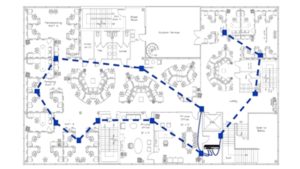The world loves all things wireless, and this love affair has consumed all the high-value spectrum below 6 GHz. In an effort to continue to meet the demand for more capacity the industry is looking to the millimeter-wave bands, and specifically the V-band up at 60 GHz. This band provides 14 GHz (57-71 in the U.S.) of unlicensed spectrum and its use has been standardized by the IEEE as 802.11ad and ay. The early focus of this spectrum was on residential broadband deployments to better compete with fiber-to-the-home (FTTH) services. We are now seeing a move toward using the V-band for indoor enterprise backbone applications. This band provides a great deal of spectrum, but one must be aware of the propagation challenges when operating at these frequencies. They can be summarized as follows:
1) Free space path loss (FSPL), as defined by Friis, increases as the square of the frequency plus the square of the distance.
Free Space Path Loss (dB) = 20log10(d) + 20log10(f) + 92.45 — where d is in kilometers and f is in GHz
While the math might seem interesting, why do we see greater path loss in the high-frequency bands? It turns out that it all comes down to the size of the receive antenna. At 60 GHz, the optimum antenna size is less than 1/2 a wavelength or about 2-millimeters, whereas, at 6 GHz, it’s an order of magnitude larger. This number gets squared for antenna sizing, and the bigger the antenna the more energy that gets captured. So, yes, a V-band signal will see an additional 20 dB of path loss as compared to a 6 GHz signal, and it doesn’t matter whether you are going 2 feet or 2 kilometers. It’s all about the size of the receive antenna. While this might sound like a negative, it really isn’t.

2) Path loss from foliage is always hard to estimate as it depends on the type of tree, the thickness of the canopy, proximity to the radio, wind, moisture in the leaves, and frequency of the RF signal. There is a very good ITU paper on the subject with an excellent chart that estimates the loss you can expect with different frequencies. Foliage is never your friend, and it gets worse as you move into the millimeter-wave bands. One great way to eliminate the problems with trees is to operate indoors.
Attenuation in Vegetation (PDF)
3) Path loss from rain is almost totally nonexistent in the bands below 6 GHz, but as you move up into the millimeter-wave bands, it becomes quite severe. At 60 GHz, you can expect about 10 dB per kilometer of loss from heavy rain, which is defined as 50 mm/hour. There is an excellent report by the FCC (Bulletin #70) that provides a lot more detail on rain fade and general atmospheric challenges. Again, this is eliminated by operating indoors where you are well away from the elements.
4) Non-line of sight (NLoS) represents all sorts of problems for the V-band because diffraction becomes much less of a factor above 10 GHz, which means multipath comes down to reflection, and reflection requires a smooth surface. A rough surface produces a much more diffuse reflection. The end result is that the millimeter bands are going to struggle in any non-line of sight situation beyond about 100 meters. A great way around this problem is to relay the signal using intermediate nodes (repeaters). These nodes can extend the range of the signal and punch through wood, glass, sheetrock, and most other building materials at short distances.
5) Oxygen absorption is a real problem up around 60 GHz, with path loss equal to 20 dB per kilometer. This greatly reduces the range of the signal, but greatly increases the spectral reuse. In high-capacity density situations, the more limited the RF propagation, the greater the spectral reuse, and very high spectral reuse enables an enormous amount of wireless network capacity. In a 60,000 square foot office building the same V-band channel can be used dozens of times without any noticeable co-channel interference. Try that with the Wi-Fi bands down at 2.4 and 5.8 GHz.
6) One great advantage with the V-band is that beamforming is easy to implement because the antenna elements (see section #1) are smaller than a thumbtack and a large phased-array can be packed into a very small enclosure. This enables the transmitter to focus a very narrow beam at the receiver. By creating a narrow beam it is possible to greatly increase the gain as seen by the receiver, which helps overcome a lot of the free space path loss (FSPL) while at the same time limiting co-channel interference. These large arrays also greatly increase the receive sensitivity.

7) This all sounds great, but what about interference? The V-band consists of unlicensed spectrum which opens up the possibility of interference from neighbor networks. This is not a problem with indoor deployments because the very limited propagation characteristics at these frequencies will prevent signals from outside your building, or even on another floor within your building, from leaking over into your deployment. Control over real estate gives you all the protection required. There is a very good whitepaper by the Facebook team for the Telecom Infrastructure Project (TIP) that looks at attenuation at 60 GHz for different types of building materials. The primary building material encountered within an office building is sheetrock which is easily penetrated by V-band signals (see chart on page 1).
TIP mmWave Networks Analysis (PDF)
These RF characteristics make the V-band ideally suited to indoor applications where there is no rain or foliage, interference is non-existent, and very high spectral reuse enables a great deal of wireless network capacity. As with everything wireless, there is no substitute for a field trial of the technology. Today’s enterprise customers will be making use of frequencies in the low-band, mid-band, and V-band. Each has value, but make sure to use the right tool for the job.
